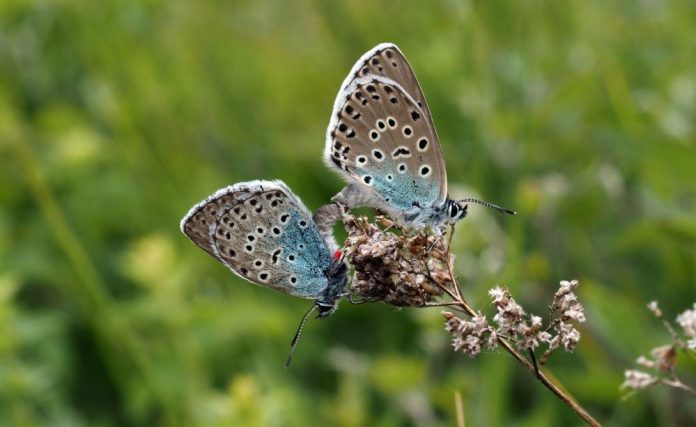The globally endangered large blue butterfly has been successfully reintroduced at Rodborough Common in Gloucestershire in efforts to halt the worldwide decline of this special insect.
The project marks the largest ever reintroduction of large blues in the UK with 1,100 larvae released on the 351 hectare (867 acre) site last August after five years of prepping the commons for their return. An estimated 750 butterflies successfully emerged on the site over the summer.
The commons, which are Sites of Special Scientific Interest and a Special Area of Conservation, were selected for release because they support all of the key elements and habitat required by the butterfly. As well as supporting fourteen species of orchid and the rare pasqueflower, the calcareous grassland is also home to a large number of rare and endangered insects including the duke of burgundy butterfly and rock rose pot beetle.
With a wingspan of more than two inches, the large blue is the largest and rarest of all nine British blue butterflies. It was last recorded at Minchinhampton and Rodborough Common 150 years ago and was declared extinct in Britain in 1979.
The butterfly was then re-introduced from continental Europe as part of a long-term conservation project nearly forty years ago and since then has established a stronghold at several core sites and has naturally colonised others across southern England.
Partners including the National Trust, Butterfly Conservation, the Limestone’s Living Legacies Back from the Brink project, Natural England, Royal Entomological Society (RES) and the Minchinhampton and Rodborough Committees of Commoners worked together to create the right conditions for the butterfly’s survival including the introduction of an innovative grazing regime and programme of scrub control.
Small, temporary grazing areas were created by using electric fences. This allowed cows, including Luing, Hereford and Long-horn cattle, to graze some of the slopes that were traditionally less attractive to the free roaming cattle throughout the year.
The combination of restricted targeted grazing and scrub control provided the right conditions for the Myrmica sabuleti ant which is vital for the butterfly’s success, as well as encouraging growth of wild thyme and marjoram where the butterfly likes to lay its eggs. These are also the main source of food for the butterflies.
David Simcox, research ecologist and co-author of the commons management plan explains: “The butterfly needs high densities of the heat-loving red ant, Myrmica sabuleti which has a crucial role to play in the lifecycle of the butterfly. The grazing cows create the ideal conditions for them by keeping the grass down so sunlight can reach the soil which gently warms it creating perfect conditions for the ants, which are cold-blooded and therefore need warmth in order to actively scout for food throughout the spring, summer and autumn.
“Then, in the summer when the ants are out foraging, nature performs a very neat trick – the ants are deceived into thinking that the parasitic larva of the large blue is one of their own and carry it to their nest. It’s at this point that the caterpillar turns from herbivore to carnivore, feeding on ant grubs throughout the autumn and spring until it is ready to pupate and emerge the following summer.”
Julian Bendle, Conservation Officer for the Back from the Brink project and Butterfly Conservation says: “Bringing such an important and rare species back to Rodborough Common is a testament to what collaborations between organisations and individuals can achieve. Creating the right conditions has been vital to the programme and this doesn’t happen overnight.”
Richard Evans, Area Ranger for the commons explains, “Butterflies are such sensitive creatures, and with the large blue’s particular requirements they are real barometers for what is happening with our environment and the changing climate.
“Large blues were once a common sight on the commons but some of the grassy slopes had become overgrown which had a severe impact on the red ant’s habitat. The long grass and scrub had caused the soil to cool which made it difficult for the ants to survive. As the ant population dwindled in the late nineteenth century, so did the numbers of large blues.
“Creating the right conditions for this globally endangered butterfly to not only survive but to hopefully thrive has been the culmination of many years work. None of this would’ve been possible without the combined efforts of conservationists and the local graziers.
“One of the greatest legacies of the re-introduction is the power of working together to reverse the decline of threatened species and the benefit the habitat improvements will have for other plants, insects, birds and bats on the commons.”
Ben McCarthy, head of nature conservation and restoration ecology said: “The National Trust manages some of the most important sites for nature and, as this project demonstrates, with a heady mix of determination, expert management and good partnerships we are playing a major role in nature’s recovery.
“But we need to step up our efforts to unleash the full potential of our land for the wildlife it can nurture and realise the benefits this provides communities through climate resilience and better access to our fabulous wildlife on ours and others land.
“The coronavirus has had major impact on our finances just as we sharpen our focus on the nature and climate emergencies. Now, more than ever, we need support so that we can continue with our vital nature conservation work to improve the state of nature in the UK and achieve carbon ‘net zero’.”















